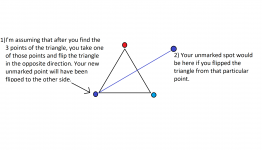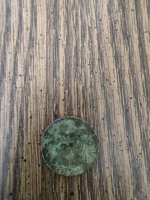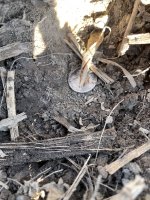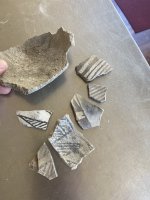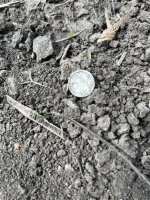You are using an out of date browser. It may not display this or other websites correctly.
You should upgrade or use an alternative browser.
You should upgrade or use an alternative browser.
A GUIDE TO VAULT TREASURE HUNTING (Condensed)
- Thread starter sandy1
- Start date
ID, any aura or crisscross spot?
Yes
Not sure about the aura its big
It is below the big 3 I showed you earlier
The crisscross is down hill a bit I never got a chance to measure that it was cold and the wind was blowing
do you want me to show the aura?
sandy1
Bronze Member
- Aug 11, 2010
- 2,282
- 4,594
- Primary Interest:
- Other
- Thread starter
- #3,703
ID, No on showing the aura, but if you have the crisscross spot and have a compass then the next thing to do is take the compass and look in the general area of 45 degrees from the crisscross spot for an owl or a large boulder that really stands out above most of the others in the area and can be up to 600 feet away if big enough but usually within 200 feet (this large boulder will have a second boulder as an alignment (line of sight) to your crisscross spot as well), another thing is that there will be more than 1 crisscross spot as I said before there are always enticers but the real one will be marked extremely well and as I was saying will have a large permanent boulder on the 45 degree line (a quadrant) placed by the original makers not the sentinels, here is the problem your compass is probably not set exactly right to be dead on with declination in your area but you should get a general idea of the direction from my declination setting that I showed earlier.
If you do find the large boulder it should be in the general direction of the aura you captured (does not have to be online)
If you do find the large boulder it should be in the general direction of the aura you captured (does not have to be online)
Last edited:
Quinoa
Bronze Member
- Nov 25, 2011
- 1,888
- 3,273
- Detector(s) used
- Garrett atx pi 12+20inch coil, Garrett mh series, Garrett 2500+t-hound attchmnt, fisher tw-6 two box, Pulsestar pro ii with various coils up to 98 inches, pulsemaster pro w/1.2 m coil
- Primary Interest:
- Other
Interesting Sandy1 is the only one on this website discussing/bringing up triangles and ways to use them. I guessed more would know/tell about them since they are at most every site in one way or another for pinpointing locations and were used even before the Spanish.
cyzak
Bronze Member
- Jul 14, 2018
- 2,344
- 3,808
- Detector(s) used
- Garrett, General Mathematics, Geometry,Pentax,,Do the math it's there.
- Primary Interest:
- All Treasure Hunting
Like Sandy1 said this info has never been given out before this is the best information any of us is going to get on this post I my self hope he has more to tell everyone here trying to learn about this type of treasure hunting.
Last edited:
AIORIA
Hero Member
- Apr 1, 2009
- 519
- 480
Interesting Sandy1 is the only one on this website discussing/bringing up triangles and ways to use them. I guessed more would know/tell about them since they are at most every site in one way or another for pinpointing locations and were used even before the Spanish.
I came across some information yesterday while researching online, that talks about "imaginary points" that the Spanish used and their triangles such as what Sandy1 has been gracefully sharing. This is very interesting info about the triangle and one of the possible ways to tackle it.
Here's what was posted by Okie Treasure hunter about the subject in 2011:
"Imaginary Points"
"As kids growing up a lot of us had really great imaginations. As adults, some of us still have really good imaginations, especially those treasure hunters looking for the ever elusive Knights of the Golden Circle treasures. Their imaginations are off the charts! "
"Having an imagination and finding an imaginary point aren’t exactly the same thing but you do have to have some of one to find any of the other."
"For the most part, I only hunt outlaw and Spanish treasures and as a general rule, the outlaws didn’t use imaginary points. The spots they took you to on a map were usually marked in some way either at the spot or on the map so that you know exactly where you are on the trail."
"The Spanish on the other hand had several ways of doing things and one of those involved what I call “imaginary points”. These points are places you have to find that aren’t marked, at least not in the normal fashion and they usually involve measuring. I hate measuring, it’s always such a pain in the butt and you usually have to do it in terrain that doesn’t lend itself to being measured easily."
"The simplest way to use an imaginary point is with a triangle. The Spanish loved triangles and used them often however, you can have a forth point tied to a triangle that gives you a spot to look for the treasure or even a buried clue or hidden map. The Spanish were known to “flip” a triangle. This is done by using three marked spots in the field that form your triangle and then flipping the triangle over along one side to give you a forth and unmarked, imaginary point. This requires you to measure the sides and angles of the original marked triangle so that you can get to an exact spot on the other side."
"The good news is that the math and measuring for this imaginary forth point is fairly simple. The bad news is, I have never found anything at a site that definitively tells you that you need to flip a triangle or which way you should flip it. This means, like most treasure hunting, you are having to work every possible solution to see if this is the actual solution. It’s about trying every possible combination until you hit on the right one or decide there isn’t anything there."
"Keep in mind imaginary points don’t happen with every triangle but they do happen and should be considered when you find a triangle laid out by the Spanish."
"Something new to me that took a couple of months to figure out is an actual corner of a triangle being an imaginary point."
"We recently worked a Spanish site that had three triangles, the most important triangle had one corner that told us there was another triangle and in what direction to look for the other corners. The third corner of the triangle was unmarked except for a flat spot to stand on a ledge. To find this flat spot and third point of the third triangle we had to use a measurement and direction they had given us with the first triangle."
"You’re probably thinking this sounds very complicated and to a point it was but on the other hand it wasn’t. The distance and direction to go to the imaginary third point was very obvious but at the time we didn’t know it took us to the third point. There wasn’t anything there except solid rock. We didn’t even know we had a third triangle when we found the distance and direction."
"We knew this information was going to be extremely important but we just didn’t know how to use it at the time. Thanks to a good mapping program, some laser range finders, a compass and a couple of months working the site we finally discovered the third, final and most important triangle."
"I still consider this third point as an imaginary one because it was not marked like the rest of the points of the three triangles. Those points all had rock piles giving specific information on where to look for the other corners of their respective triangles. The “imaginary point” could only be found by using the distance and direction given. I will also say that the imaginary point turned out to be the dead center of the first triangle. The spot that was the imaginary point was on a ledge about ten feet high and the flat spot of the ledge was about one and a half feet wide and just a couple of feet long. Just enough for a person to stand on and take a compass heading."
"These are by no means the only ways to use an imaginary point and I don’t want you going out in the field and just imagining anything. Use some common sense and keep in mind that if you have an imaginary point there has to be a very specific and exact way to get to that point. It will require the dreaded measuring technique to find these points and you will have definite markers to measure from."
Last edited:
cyzak
Bronze Member
- Jul 14, 2018
- 2,344
- 3,808
- Detector(s) used
- Garrett, General Mathematics, Geometry,Pentax,,Do the math it's there.
- Primary Interest:
- All Treasure Hunting
I would like to see a site drawn out like that just one time it would make it so much simpler to understand excellent research tho A.
Last edited:
AIORIA
Hero Member
- Apr 1, 2009
- 519
- 480
I would like to see a site drawn out like that just one time it would make it so much simpler to understand excellent research tho A.
Cyzak, I've attempted to show in this diagram how to find the 4th point of the triangle that the information talks about.
Attachments
sandy1
Bronze Member
- Aug 11, 2010
- 2,282
- 4,594
- Primary Interest:
- Other
- Thread starter
- #3,710
Here you go Cyzak,
This is an overview of the triangle I showed with the 130 foot legs
I marked each point but what I have not shown before is that the Shaft Sign Line as well as the second A-Frame Rock Line are both exactly 49 degrees (7x7) off opposite sides of the line going to the Rabbit point of the triangle from the crisscross spot and of course both of those A-Frames originally helped to find the crisscross spot by aligning to it through other boulders.
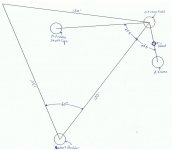
This is an overview of the triangle I showed with the 130 foot legs
I marked each point but what I have not shown before is that the Shaft Sign Line as well as the second A-Frame Rock Line are both exactly 49 degrees (7x7) off opposite sides of the line going to the Rabbit point of the triangle from the crisscross spot and of course both of those A-Frames originally helped to find the crisscross spot by aligning to it through other boulders.

Last edited:
cyzak
Bronze Member
- Jul 14, 2018
- 2,344
- 3,808
- Detector(s) used
- Garrett, General Mathematics, Geometry,Pentax,,Do the math it's there.
- Primary Interest:
- All Treasure Hunting
Thank you Thank you, this information is solid gold a picture means a thousand words. For you guys to take the time to explain this means a lot to me i hope others will benefit from the information relayed here.





AIORIA
Hero Member
- Apr 1, 2009
- 519
- 480
Here you go Cyzak,
This is an overview of the triangle I showed with the 130 foot legs
I marked each point but what I have not shown before is that the Shaft Sign Line as well as the second A-Frame Rock Line are both exactly 49 degrees (7x7) off opposite sides of the line going to the Rabbit point of the triangle from the crisscross spot and of course both of those A-Frames originally helped to find the crisscross spot by aligning to it through other boulders.
View attachment 1658199
Thank you for posting this info Sandy1. That is very interesting how both lines are off 49 degrees going to the rabbit boulder. Does that mean that 49 degrees would somehow be used from a different point of the triangle to find the dig spot? Just taking a wild guess here.
sandy1
Bronze Member
- Aug 11, 2010
- 2,282
- 4,594
- Primary Interest:
- Other
- Thread starter
- #3,713
No, they used multiple holy degrees at different sites 49 degrees is just one of them I have also seen 39 (3x13) degrees and 21 (3x7) degrees off other lines as well as those degrees as actual standalone degree lines.
Last edited:
Carl-NC
Bronze Member
- Mar 19, 2003
- 1,871
- 1,359
- Detector(s) used
- Custom Designs and Prototypes
- Primary Interest:
- All Treasure Hunting
I came across some information yesterday while researching online, that talks about "imaginary points" that the Spanish used and their triangles such as what Sandy1 has been gracefully sharing. This is very interesting info about the triangle and one of the possible ways to tackle it.
Here's what was posted by Okie Treasure hunter about the subject in 2011:
"Imaginary Points"
"As kids growing up a lot of us had really great imaginations. As adults, some of us still have really good imaginations, especially those treasure hunters looking for the ever elusive Knights of the Golden Circle treasures. Their imaginations are off the charts! "
"Having an imagination and finding an imaginary point aren’t exactly the same thing but you do have to have some of one to find any of the other."
"For the most part, I only hunt outlaw and Spanish treasures and as a general rule, the outlaws didn’t use imaginary points. The spots they took you to on a map were usually marked in some way either at the spot or on the map so that you know exactly where you are on the trail."
"The Spanish on the other hand had several ways of doing things and one of those involved what I call “imaginary points”. These points are places you have to find that aren’t marked, at least not in the normal fashion and they usually involve measuring. I hate measuring, it’s always such a pain in the butt and you usually have to do it in terrain that doesn’t lend itself to being measured easily."
<snip>
Is there any backing historical documentation to support any of this? I constantly read about what all the Spanish did in hunting for treasure (such as dowsing) and hiding treasure but it all seems to be completely unsupported by any real evidence. Genuinely curious.
Quinoa
Bronze Member
- Nov 25, 2011
- 1,888
- 3,273
- Detector(s) used
- Garrett atx pi 12+20inch coil, Garrett mh series, Garrett 2500+t-hound attchmnt, fisher tw-6 two box, Pulsestar pro ii with various coils up to 98 inches, pulsemaster pro w/1.2 m coil
- Primary Interest:
- Other
Sure Carl, there must be many college textbooks written on the subject of treasure recovery for the modern man. In fact I heard it's a core class in archaeology to know all about the geometry of the ancients all the way up thru spanish on how they kept their mines, tombs and vaults secret here in america and every where else and how they marked them, for all to see and enjoy and just go out dig up anytime you want. There are no secrets kept when dealing with things of wealth like gold , jewels, crypts of ancient kings or lost knowledge. We know everything we need to and have since grade school when we learned in cub scouts the sun rose exactly due east and set due west.
So we need to keep looking for that accredited documentation on this stuff because someone must have wrote a complete textbook about it. Because that's how to do research. You have to research something that's already known and established otherwise you are just wasting time.
So we need to keep looking for that accredited documentation on this stuff because someone must have wrote a complete textbook about it. Because that's how to do research. You have to research something that's already known and established otherwise you are just wasting time.
AIORIA
Hero Member
- Apr 1, 2009
- 519
- 480
Sure Carl, there must be many college textbooks written on the subject of treasure recovery for the modern man. In fact I heard it's a core class in archaeology to know all about the geometry of the ancients all the way up thru spanish on how they kept their mines, tombs and vaults secret here in america and every where else and how they marked them, for all to see and enjoy and just go out dig up anytime you want. There are no secrets kept when dealing with things of wealth like gold , jewels, crypts of ancient kings or lost knowledge. We know everything we need to and have since grade school when we learned in cub scouts the sun rose exactly due east and set due west.
So we need to keep looking for that accredited documentation on this stuff because someone must have wrote a complete textbook about it. Because that's how to do research. You have to research something that's already known and established otherwise you are just wasting time.
Sarcastic but very true...
Secret squirl
Sr. Member
- Sep 15, 2017
- 278
- 313
- Detector(s) used
- pulsestar II pro
- Primary Interest:
- All Treasure Hunting
Sure Carl, there must be many college textbooks written on the subject of treasure recovery for the modern man. In fact I heard it's a core class in archaeology to know all about the geometry of the ancients all the way up thru spanish on how they kept their mines, tombs and vaults secret here in america and every where else and how they marked them, for all to see and enjoy and just go out dig up anytime you want. There are no secrets kept when dealing with things of wealth like gold , jewels, crypts of ancient kings or lost knowledge. We know everything we need to and have since grade school when we learned in cub scouts the sun rose exactly due east and set due west.
So we need to keep looking for that accredited documentation on this stuff because someone must have wrote a complete textbook about it. Because that's how to do research. You have to research something that's already known and established otherwise you are just wasting time.
Let not forget about fossil fuels. Public schools were a great idea!
Chadeaux
Gold Member
- Sep 13, 2011
- 5,512
- 6,408
- Detector(s) used
- Ace 250
- Primary Interest:
- Cache Hunting
Sure Carl, there must be many college textbooks written on the subject of treasure recovery for the modern man. In fact I heard it's a core class in archaeology to know all about the geometry of the ancients all the way up thru spanish on how they kept their mines, tombs and vaults secret here in america and every where else and how they marked them, for all to see and enjoy and just go out dig up anytime you want. There are no secrets kept when dealing with things of wealth like gold , jewels, crypts of ancient kings or lost knowledge. We know everything we need to and have since grade school when we learned in cub scouts the sun rose exactly due east and set due west.
So we need to keep looking for that accredited documentation on this stuff because someone must have wrote a complete textbook about it. Because that's how to do research. You have to research something that's already known and established otherwise you are just wasting time.
Oh, and don't forget about how that textbook must have documentation. Everything must be traceable to each individual who oversaw the operation and must be backed up by written testimony of the government official who placed them in that position. Those documents without proper legal documentation will not qualify. They must be attested to by at least three high ranking officials of the realm.
Wanting "accredited" or "scholarly" documentation that backs up what is/has been learned is like wanting John Doe, a multimillionaire, to make public his bank account numbers, passwords, pins, etc. for use by the general public so that Slick Rick can "prove" John really is a multimillionaire by draining his bank accounts.
Last edited:
Hello Carl, it seems you worry about imaginations, SOO, where would your metal detector be WITHOUT imagination? OR how about the point of the sundial? How could such come about without imagination.
Sorry Sandy, could not help myself as my imagination is like kittycat.
Sorry Sandy, could not help myself as my imagination is like kittycat.
Is there any backing historical documentation to support any of this? I constantly read about what all the Spanish did in hunting for treasure (such as dowsing) and hiding treasure but it all seems to be completely unsupported by any real evidence. Genuinely curious.
I’ve run across a couple things in my research that mention outlaw setups. The best was in a book Banditti of the Prairie. It describes a simple site of three markers that were used to hide money from a robbery. Charles Kenworthy wrote books that described Spanish treasure hiding techniques. Some people question his research but I have seen some odd things, in the field, that he describes. If you are lucky enough to find a place, in the field, that has some of the things our posters share, you can see how your site compares with others.
Users who are viewing this thread
Total: 4 (members: 0, guests: 4)


